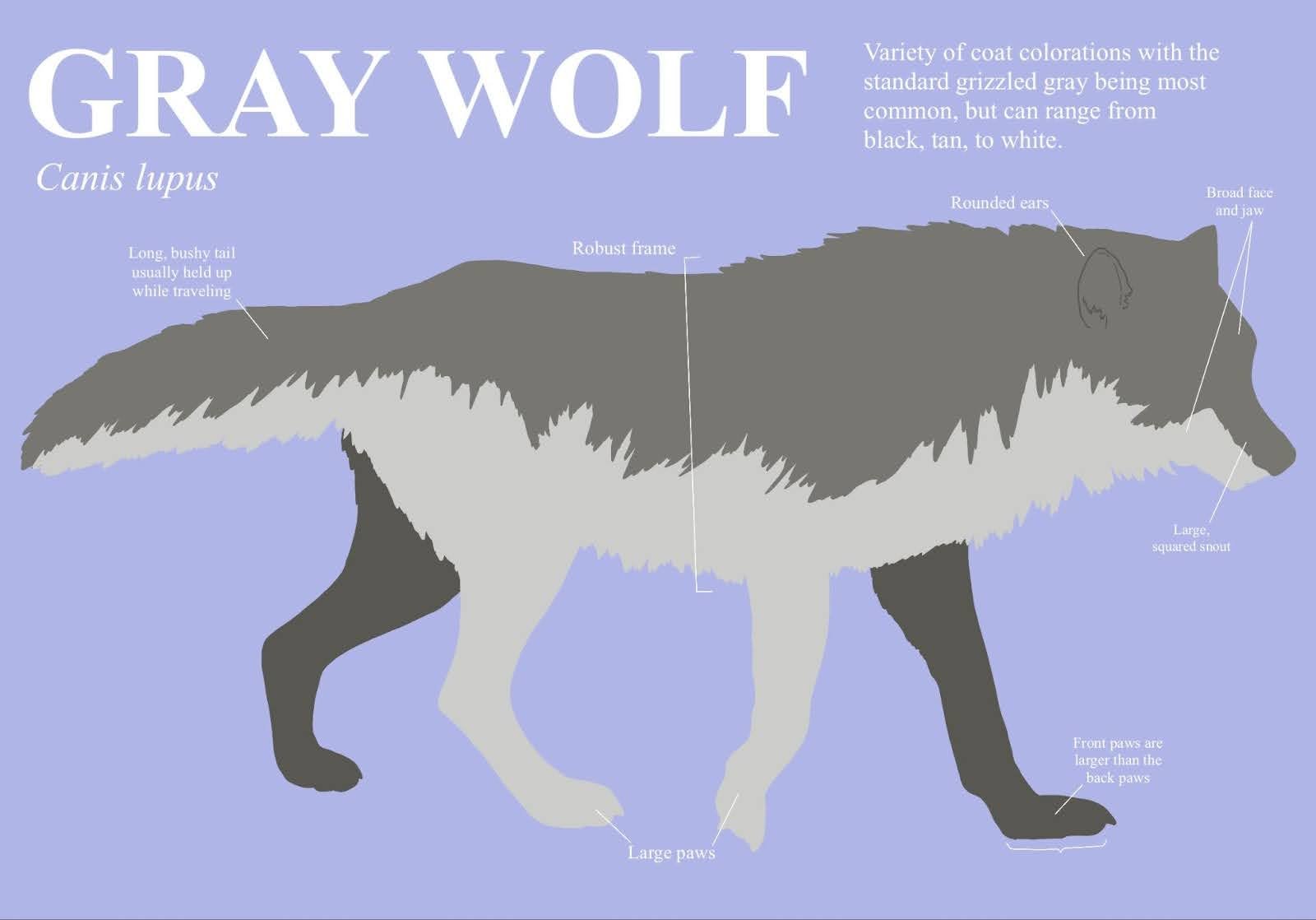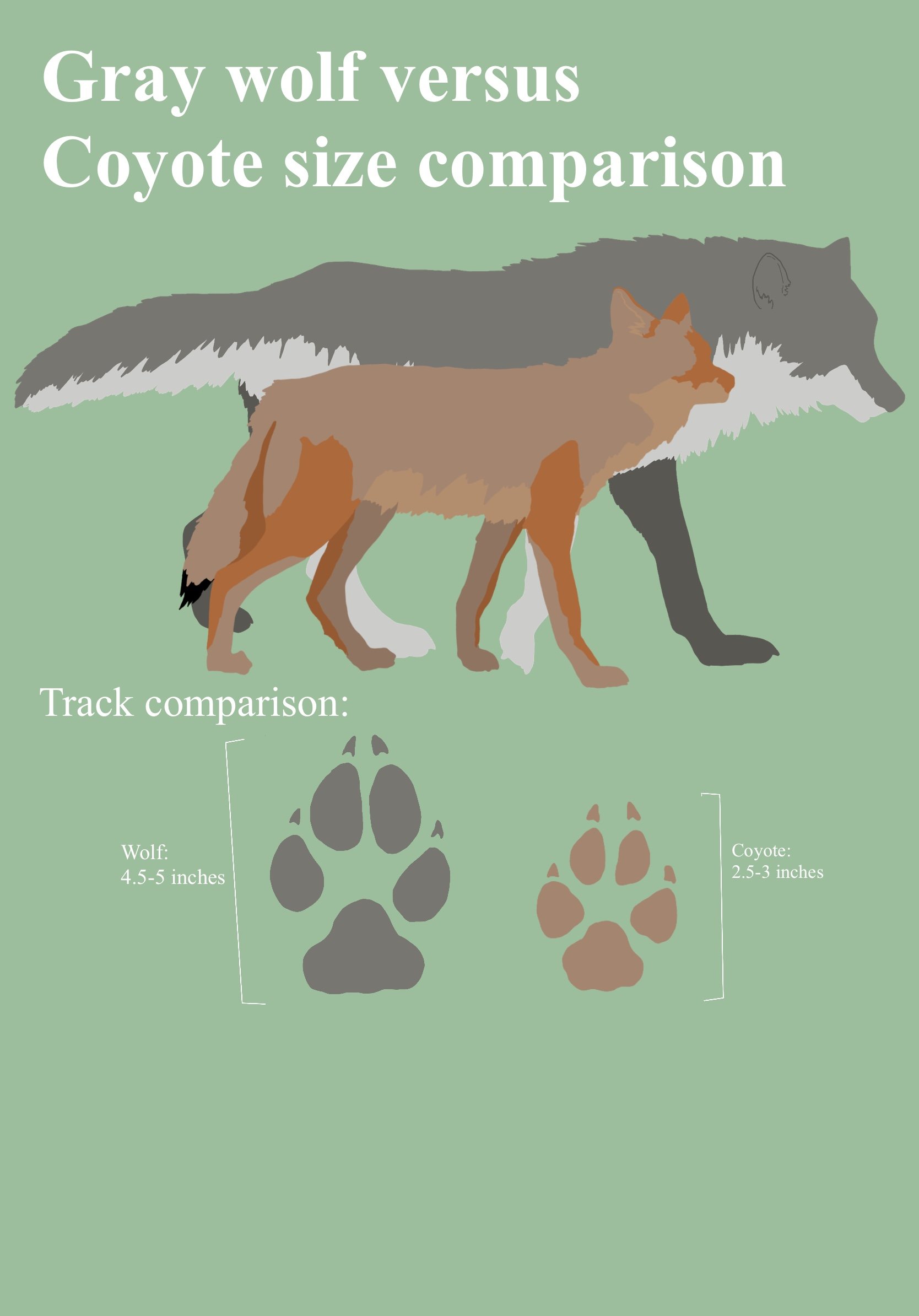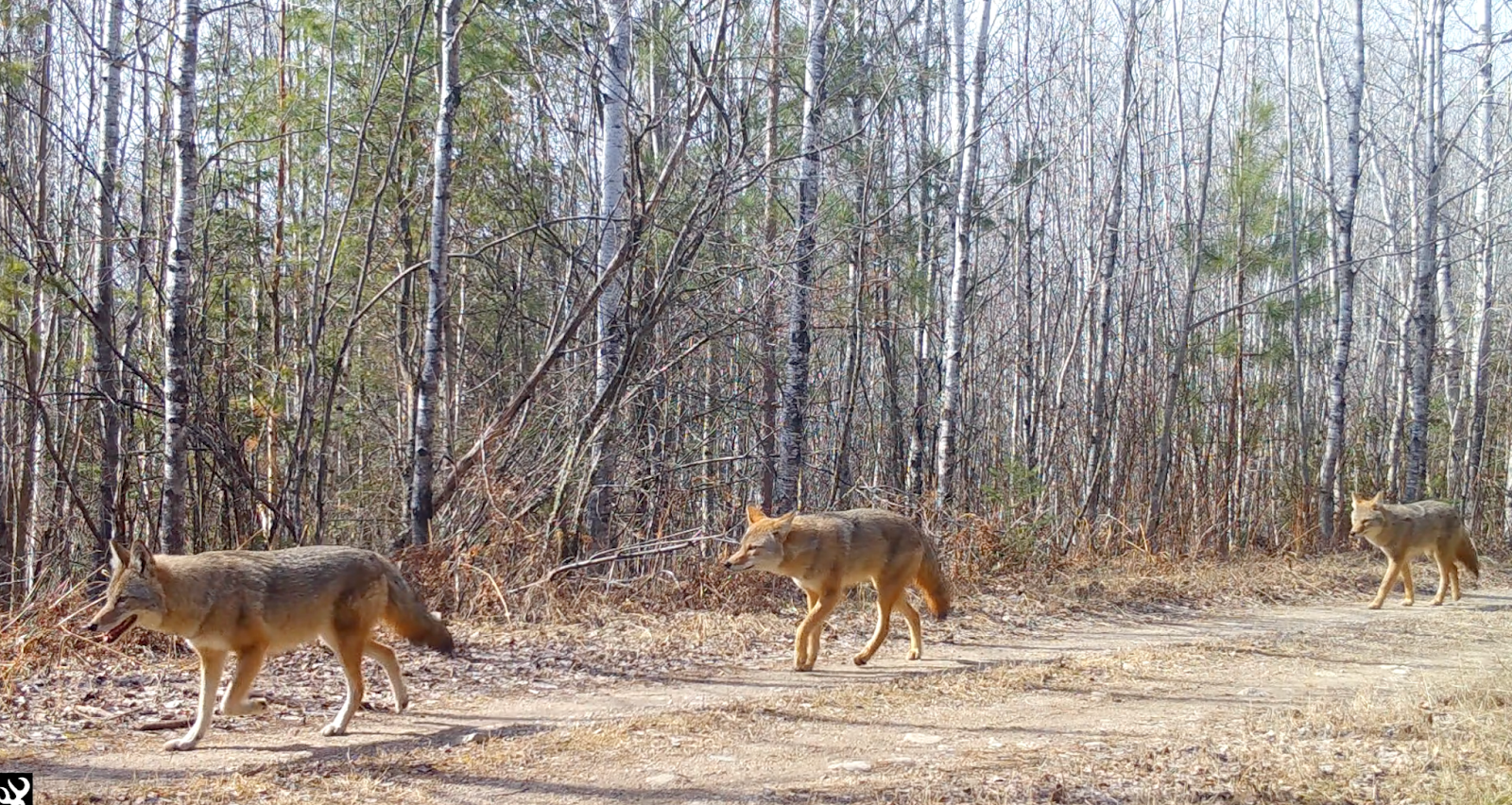Wolves and Coyotes in Minnesota: A closer look at two iconic canines
Written by Maeve Rogers, Wolf Predation & Research Technician
In the expansive wilderness of Minnesota, where forests stretch as far as the eye can see and the haunting howls of predators echo through the night. Venture along the main highway bordering Voyageurs National Park at night, and you may just be greeted by two distinct sounds. The deep, haunting howls signify the enduring presence of a centuries-old inhabitant. Meanwhile, the sharp, high-pitched yips signal the presence of another. Two iconic members of the canine family roam the land: the gray wolf (Canis lupus) and the coyote (Canis latrans). While both species share similar habitats and behaviors, they also exhibit distinct differences that contribute to their unique roles in the ecosystem.
However, the question arises: In the obscurity of the night, how does one discern the nuanced differences between a wolf and a coyote?
Minnesota's vast and diverse landscapes are home to a rich array of wildlife, including two of the most iconic and enigmatic members of the canine family – the gray wolf and the coyote. While these two species belong to the Canidae family, they share certain similarities. However, they also exhibit distinct differences in their appearance, behavior, ecology, and impact on the ecosystem.
Identifying wolves from coyotes may seem straightforward due to the significant size difference, with adult wolves often towering two to three times larger. However, confusion persists, leading to ecological and legal implications.
The gray wolf is federally listed in the Endangered Species Act (ESA) as either threatened or endangered in the lower 48, including Minnesota where it is listed as threatened. In contrast, coyotes lack protection under the ESA or any defense at the state or federal level. Specifically in Minnesota, coyotes are unprotected and can be taken at any time through shooting or trapping. This article aims to explore the distinctive features that differentiate these canines, examining both their similarities and differences.
The Gray Wolf
Gray wolves, also referred to as timber wolves in Minnesota, exhibit distinctive features that set them apart in the wild. Once on the brink of extinction in Minnesota, concerted conservation efforts have led to a remarkable recovery of wolf populations in recent decades. Today, these predators play a crucial role in maintaining the balance of ecosystems throughout the state.
Appearance and Size
One of the most striking features of the gray wolf is its sheer size and formidable presence. Adult wolves typically weigh between 60 to 120 pounds depending on geographical location, with males generally larger than females. Insights gathered from the Voyageurs Wolf Project in northern Minnesota have found that, on average, wolves in this region weigh between 60-62 pounds. However, the wolf population is not a one-size-fits-all. While certain adult female wolves in the area may weigh a modest 40 pounds, adult male wolves have been recorded weighing in the 80-pound range at the time of capture. In 2021, the project captured one exceptional solitary male wolf weighing 91 pounds. Weighing wild wolves poses a challenge as it's not an exact science due to the fact that an average wolf can carry up to 20 pounds of food in their stomach at any given time!
Wolves typically possess taller, longer, and bulkier physiques, measuring between four to five feet in length on average. They have long, bushy tails that often sport black tips, while their coats exhibit a blend of gray and brown hues, complemented by buffy facial markings and undersides. The coloration of wolves varies from solid white to brown or black, contributing to their visual diversity. Additionally, wolves possess slightly more rounded ears, boxier snouts, broader heads, and fur around their necks and faces that appears more tufted, akin to a parka.
Credit: Maeve Rogers
Habitat and Range
Gray wolves are highly adaptable creatures, capable of thriving in a variety of habitats ranging from dense forests to rugged mountains. In Minnesota, these apex predators primarily inhabit the northern and central regions of the state, where vast stretches of wilderness provide ample prey and suitable den sites. They are known to roam across extensive areas of land, with pack territories sometimes spanning hundreds of square miles. Territories are typically somewhere between 40-60 square miles, but the average summer homerange discovered for wolves in northern Minnesota is roughly 45 square miles (Gable 2016).
Diet
Wolves in Minnesota exhibit remarkable adaptability in hunting strategies, seamlessly transitioning between pursuit and ambush predation based on prey availability. They primarily pursue ungulates like white-tailed deer, elk, and occasionally moose. Wolves seem to make a switch to ambushing foraging beavers during the ice-free season. Additionally, wolves opportunistically hunt rodents, small mammals, waterfowl, game birds, insects, and even spawning fish in the right conditions. They can also switch to foraging strategies when prey is not as abundant. Research from the Voyageurs Wolf Project reveals that berries constitute a significant portion of their diet, comprising 56–83% of weekly biomass until mid-August (Gabel et al., 2018). Another significant portion of a wolfs’ diet comes from scavenging carrion, which is the decomposing flesh of another animal. They take advantage of a variety of carcasses like winter-killed animals (animals that succumbed to harsh winter conditions like deer, moose, etc), road kill, hunter-killed animals, gut piles left from hunters, and even other wolves. It's quite a feast when they dine, as adults can consume up to 20 pounds of meat in a single meal.
Pictured: Two wolves traveling together. Notice the broad heads and jaws, rounded ears, thick builds, striking facial markings, tail position, and thick necks. Credit: Voyageurs Wolf Project
Social Structure and Behavior
At the heart of wolf society lies the pack, a tightly-knit family unit governed by a complex hierarchy. Packs typically consist of a dominant breeding pair, known as the breeding male and female, along with their offspring from previous years. The term 'alpha' was previously used to describe wolf pack structure but has since been revised with the recognition that wolf packs operate through shared leadership among the breeding pair. This model contrasts with the notion of sole leadership by a single individual, as implied by the term 'alpha'. These family bonds are strengthened through intricate social rituals, including communal hunting and vocal communication through howls, body language, and play.
The Coyote
While usually not seen as iconic as their larger cousins, coyotes are nonetheless integral components of Minnesota's diverse ecosystems. Renowned for their resilience and adaptability, these resourceful predators have thrived in a variety of landscapes, including urban environments where they have earned a reputation for their cunning and elusive nature.
Appearance and Size
Coyotes are smaller in stature compared to gray wolves, typically weighing on average between 20 and 30 pounds in Minnesota. Like wolves, they also possess some size variations with some individuals reaching into the 37-38 pound range in the state. They possess a slender build, with long legs and a bushy tail that aids in balance and communication. Their fur ranges in color from grayish-brown to reddish-blonde, providing effective camouflage in a variety of habitats.
Credit: Maeve Rogers
Habitat and Range
Unlike gray wolves, which tend to favor remote wilderness areas, coyotes are remarkably versatile in their choice of habitat. From the dense woodlands of northern Minnesota to the sprawling prairies of the southern plains, these adaptable predators can be found throughout the state. Coyotes have even established thriving populations in suburban and urban areas, where they capitalize on readily available food sources and shelter.
Diet
While coyotes primarily function as predators, they also exhibit remarkable opportunism in their feeding habits, adapting their diets to capitalize on the most accessible prey. Their adaptability and opportunistic nature when it comes to diet is similar to wolves. Some of the primary food sources for coyotes are small rodents, various fruits, white-tailed deer, and snowshoe hare. They are also major scavengers, often benefiting from wolf-killed prey, yet they can pivot towards actively hunting larger prey when the opportunity arises. This versatile approach underscores the coyote's adaptability and resourcefulness in varied environments.
Social Structure and Behavior
Coyotes exhibit a more solitary lifestyle compared to the highly social nature of gray wolves. While they may form temporary pair bonds during the breeding season, coyotes are primarily solitary hunters, relying on stealth and cunning to capture prey. They are opportunistic feeders, with diets consisting of small mammals, birds, insects, and even fruits and vegetation when available. Coyotes are also major scavengers, and often make use of wolf-killed prey, road kill, hunter discards, and more if possible.
Ecological Role and Conservation
Credit: Maeve Rogers
Both gray wolves and coyotes play vital and unique roles in shaping the ecosystems of Minnesota. As apex predators, gray wolves help regulate prey populations and prevent overgrazing while also promoting biodiversity. Their presence also influences the behavior and distribution of prey species, leading to cascading effects throughout the food web. Studies have shown that wolves alter wetland creation and recolonization by preying on an ecosystem engineer like the beaver. Through this relationship, wolves as predators have also shaped the trajectory and composition of forests.
The relationship between Coyotes, meanwhile, serve as important mesopredators, helping control populations of rodents and smaller mammals. The relationship between coyotes and small rodents and mammals can serve as a beneficial form of rodent control near urban areas.
The narrative of the gray wolf stands as one of the most captivating stories in American wildlife history. Once abundant across North America, the wolf faced relentless hunting and was eradicated from nearly all of their historic range. However, despite the hefty efforts to eradicate the species, a small population persisted in northern Minnesota near Voyageurs National Park. Thanks to robust conservation initiatives, the wolf is now experiencing a resurgence in some of its former range. With its return, the gray wolf assumes a pivotal role in maintaining the health and balance of ecosystems.
Challenges and Coexistence
Despite their ecological importance, both gray wolves and coyotes face ongoing threats in Minnesota. Habitat fragmentation and loss, human encroachment, and conflicts with livestock and domestic pets pose significant challenges to their survival. Additionally, misinformation and misconceptions surrounding these canines have fueled controversial debates over conservation and management practices. In recent years, organizations such as the Minnesota Department of Natural Resources (DNR), the Voyageurs Wolf Project, and the International Wolf Center have spearheaded efforts to promote coexistence. Through research, education, and community outreach initiatives, these organizations strive to foster a deeper understanding of the ecological roles played by wolves and coyotes, while also addressing concerns related to various human concerns and livestock protection.
Pictured: Three coyotes traveling together. Notice the narrow snouts, pointed ears, slender legs, orangey coat colors, and tail position. Credit: Voyageurs Wolf Project
In the vast and untamed wilderness of Minnesota, the gray wolf and the coyote stand as living symbols of resilience, adaptability, and ecological significance. While each species possesses its own unique traits and behaviors, they share a common bond as integral components of the North Woods ecosystem. As stewards of the land, it is our collective responsibility to safeguard the future of these predators along with their prey and habitats to ensure their continued presence in Minnesota's wild places. By fostering coexistence, promoting conservation efforts, and embracing the inherent value of all our wildlife, we can preserve the rich tapestry of life that defines our state's natural heritage for generations to come.
Trail Camera Pictures For Comparison
Pictured above are three coyotes traveling together. Notice the narrow snouts, pointed ears, slender legs, orangey coat colors, and tail position.
Pictured above are a wolf(left) and a coyote (right) traveling down the same trail. You can see the distinct differences between the ears, head, legs, frame, and body posture. Credit: Voyageurs Wolf Project
Pictured above is a photomontage of two pictures demonstrating the size difference between coyotes (left) and a wolf (right) on the same trail camera. When side-by-side, adult wolves and coyotes have very noticeable differences in size. Credit: Voyageurs Wolf Project
There can be slight overlaps in weight and length ranges between the two species, particularly among young wolves like pups and smaller yearlings. Here is a good capture comparison between a wolf pup and a coyote. Credit: Voyageurs Wolf Project
Pictured above is a collage of wolf pups (left side) and adult coyotes (right side) pictures. Differences, even though more challenging to point out, are still present between head, ears, snout, fame, and legs. Credit: Voyageurs Wolf Project
References
All pictures were captured on trail cameras by the Voyageurs Wolf Project
Art and Diagrams were drawn by Maeve Rogers
Gable, T.D. 2016. Wolf predation: where and how wolves kill beavers, and confronting the biases in scat-based diet studies. MSc. Thesis, Northern Michigan University, Marquette.
Gable, T.D., Windels, S.K., Bruggink, J.G. and Barber-Meyer, S.M., 2018. Weekly summer diet of gray wolves (Canis lupus) in northeastern Minnesota. The American Midland Naturalist, 179(1), pp.15-27.
Gable, T.D., Johnson-Bice, S.M., Homkes, A.T., Windels, S.K., and Bump, J. K. 2020. Outsized effect of predation: Wolves alter wetland creation and recolonization by killing ecosystem engineers. Science Advances, 6(46), eabc5439. doi:10.1126/sciadv.abc5439










